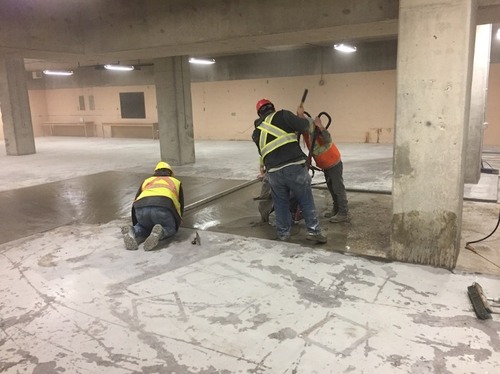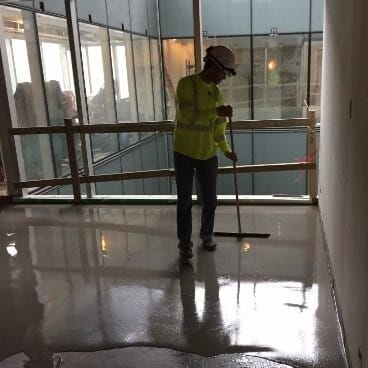
Homeowners who spend a lot of money to perfect the design of their home want to maintain its high-quality finishes. In the years ahead, you want to ensure that your home looks just as good as the day it was completed. While some wear and tear can ultimately make a home more beautiful, it also has the potential to be a major eyesore.
Concrete floors are a source of trepidation for many homeowners. It’s common knowledge for most individuals that concrete has the propensity to crack over time. When the floors are first installed, they are beautiful and chic. However, they may not completely withstand the test of time if you’re interested in keeping one monolithic surface.
Some people will love the rustic feel that these minor cracks give their home. They can increase the cozy ambience and add genuine warmth to a particular area. Others will view these imperfections as an eyesore that must be handled swiftly.
If you’re concerned about the potential for cracking in your concrete floors, these commonly asked questions will help you to make an informed decision about how to handle this situation.
Why does cracking occur?
Before you can really develop a full understanding of what to do with cracks, it’s important to understand why they occur. No concrete surface will be completely devoid of cracks or pitting as the years continue to pass. It’s important to note in the very beginning that cracking isn’t generally dangerous to the structural integrity of your flooring.
Concrete will often crack as a result of an imbalanced mixture of concrete to water. Adding extra water to the mixture makes it easier for contractors to place the concrete, but it does lower the overall strength of the material. Cracks can occur when the concrete starts to dry and water evaporates from the wet mixture. Because there is an excess amount of water, the concrete shrinks much more rapidly than it should and cracks begin to form on the surface.
Another common reason that concrete may crack is when the foundation dries too quickly. This may happen if there isn’t enough water in the original mixture. Clearly, understanding the proper ratio of cement to water is crucial to laying a concrete slab that minimizes cracking.
Because water is a primary ingredient in concrete, it is also prone to expand and contract based on the temperature. Your concrete slab may swell up in the summer as it absorbs humidity from the warmer air, even if it isn’t visible to the naked eye. When winter time rolls around, the concrete may shrink in the cold air and cause cracking on the surface.
As you can see, cracking is an extremely natural part of the process when it comes to curing concrete. It’s unavoidable to have at least a few very minor cracks in any surface.
Can I repair cracks?
In some cases, you may be able to repair the cracks that occur in your concrete. If the crack is severe, this may be your best option in order to prevent dirt and debris from falling into the affected area. You have a couple of options for how cracks can be repaired.
The most extensive repair will involve clearing out the cracked concrete, cleaning the area, and installing new cement with a resurfacer. This method requires a lot of hands-on knowledge and experience to finish it well. Homeowners who are faced with a crack intense enough to require this type of repair should contact a professional to assist them.
Less severe cracking can be corrected with resin injections or concrete filler. This is a slightly more minor concrete repair in Winnipeg that handy homeowners may be able to complete on their own. While you may have difficulty blending it into the floor around it, you may be able to at least patch the crack less noticeably.
If you doubt your ability to perform the repair yourself, you should always contact a concrete professional first. This can save you from more expensive repairs in the near future if the repair is completed incorrectly. It’s better to be safe than sorry with these types of home repairs.
Some minor cracks are to be expected with concrete flooring. Instead of rushing to fill each crack as it happens, you may want to take a few steps to simply minimize or decorate their appearance instead.
What can I do to minimize the appearance of minor cracks?
Once you know that some cracks are going to be inevitable, you can start to consider the steps you may want to take to minimize their appearance. Many homeowners prefer to incorporate these cracks into their design scheme in order to prevent them from standing out. Particularly if you were planning to stain or add a textural element to your concrete flooring, this can be a simple process.
Some homeowners choose to leave the cracks untouched, especially if they are relatively small. This can add to a more industrial vibe or create a rustic chic ambiance. If this style will suit you, the cracks can be a beautiful addition to your home.
However, some homeowners prefer to make the cracks appear more intentional in the design of their floors. You may consider adding stain or dye into the cracks to draw more attention to them. At first glance, this method may appear counterintuitive to minimizing the appearance if blemishes. With repetition throughout the floor, this creative strategy can actually make your floor appear more purposefully rustic.
If your installer is extremely creative, they may be able to work the cracks into a more elaborate pattern. They could create a design that resembles a flagstone pathway, a stencil, or add a saw-cut pattern.
Don’t let the thought of cracked concrete deter you from using this truly beautiful floor covering in your home. Your living areas will be just as beautiful with these cracks as it would be without them. These “blemishes” are a huge part of the inherent beauty of a concrete floor covering. Your home will be perfectly imperfect with this durable and high-quality floor covering.

